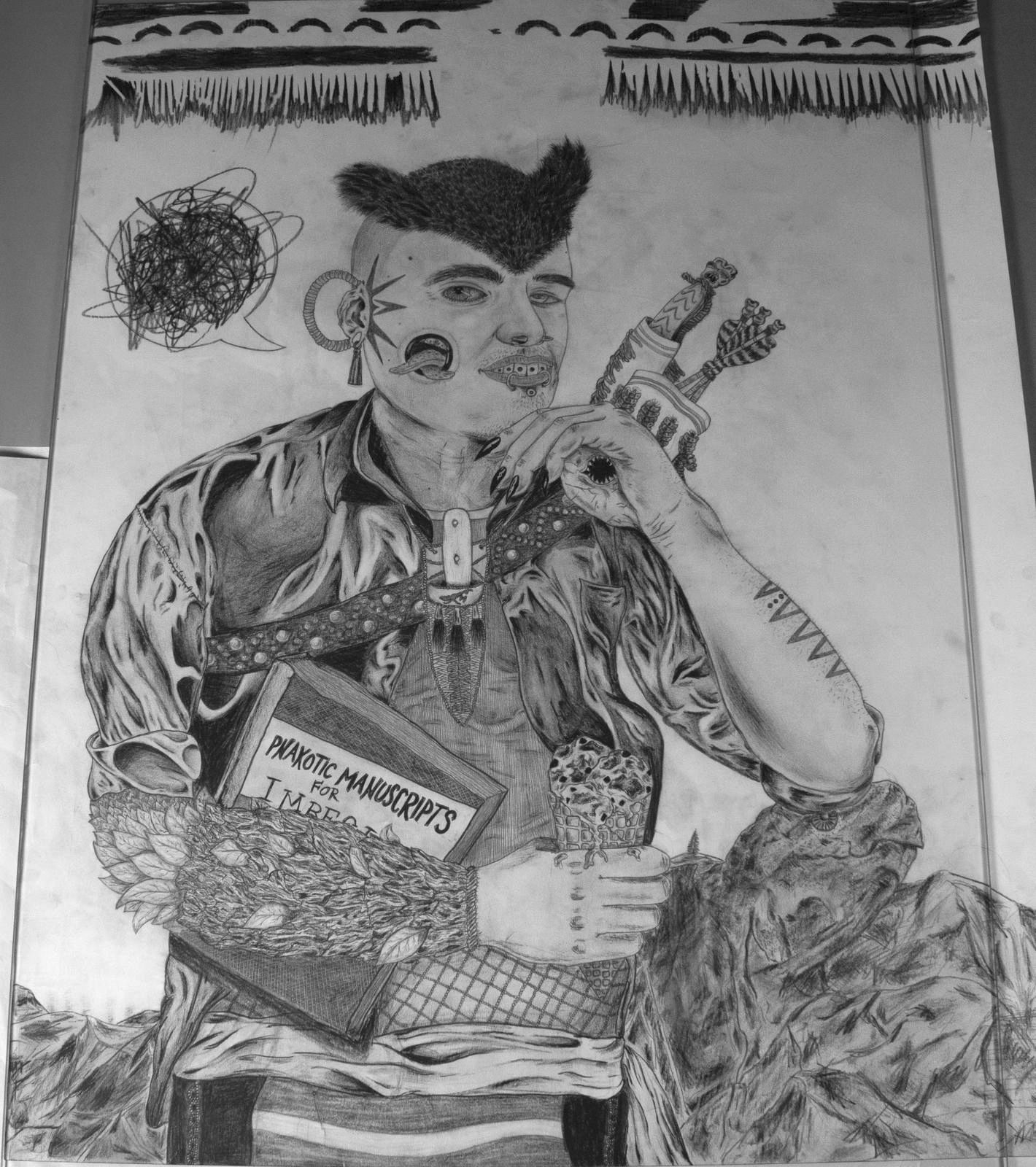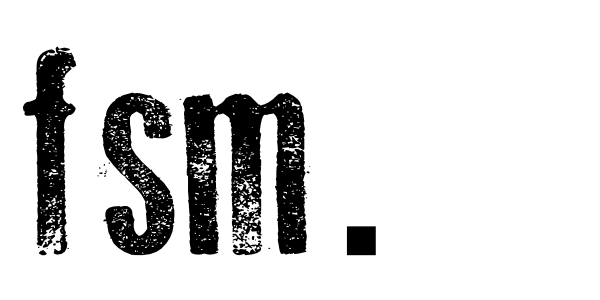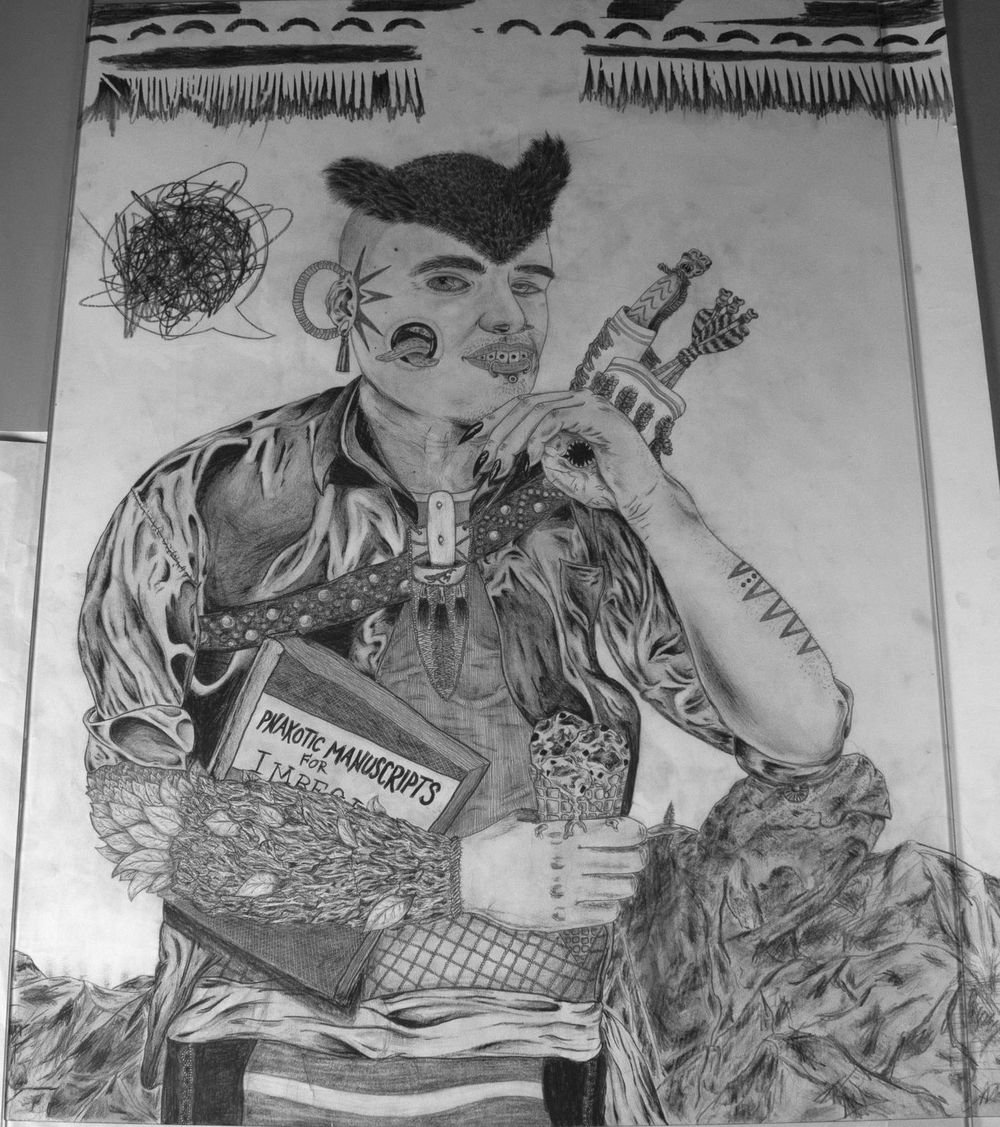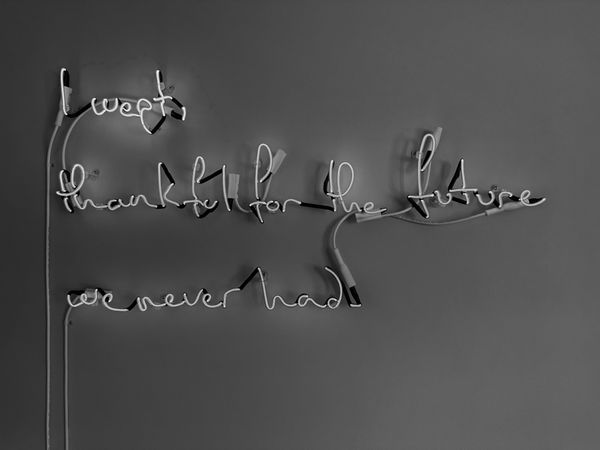Excerpt of an interview with Leovardo Aguilar
by Cristian Andersson
Cristian: So, how are things going?
Leovardo: Busy but in a good way, I suppose. I got work, school, you know, family. And then, you know, I’m trying to do art here and there.
C: That’s always important. Is your family in Sheboygan?
L: Yeah. I got a brother, a sister, nieces, my girlfriend, and her family. I have an 11-year-old daughter. We were watching my daughter and her younger brother this past weekend, so that was fun.
C: That’s cool. What do they like to do? Does your daughter make art also?
L: She started getting into it a little bit more recently. You know, for a long time, I’ll admit I was kinda disappointed. She didn’t draw or do anything, but in fifth grade, she’s in sixth grade right now, so she started kind of drawing and stuff like that, so that’s fun.
C: That’s great. So, what I was thinking is the next issue of fsm. it would be great to include, your self-portrait drawing. But then I also wanted to do some kind of interview. fsm. is about trying to connect artists with the community and say: this is what we do, this is why we do it, and kind of, you know, just make a better conversation about the arts than something that’s kind of like surface level.
L: Sure. One of the biggest things for me, like when I was in grade school up until high school, was art. Drawing was kind of an escape from my responsibilities, you know? I didn’t want to do my homework, and I didn’t want to pay attention in class. I’d sit and draw and write. And after I left school, I lost all of it. You know, whatever inspiration I had or whatever kind of sense of self as an artist I had, I lost for many years. And it’s just these past couple years, maybe let’s say like past two years really, where I’ve been getting back into it. I need to make something. You know, I used to wait until I was bored and think okay, I’ll make something to pass the time. And now, I’m like, no, I need to sit down and, and make something. I think that’s an interesting new process for me.
C: What do you think you lost not doing your work? Did you gain anything from time away because you are older and have had different experiences?
L: I don’t know what I’ve gained yet, but I know I’ve lost a lot. That’s what hurt the most. I had this whole mindset on who I was. It really showed in my drawings, and as I grew older, I’m not that person anymore. I don’t know who, and I don’t know what to draw. Or how to draw I don’t have a style. I used to have a style of drawing and I couldn’t even like, replicate it anymore. So, I was so lost and I’m still trying to maneuver through that.
C: Do you think artists, when they’re younger, it’s important to have a style? Or should they just kind of mess around and, and try different things?
L: It’s funny you say that. In school, it was always pencil or pen and paper. Black and white. I did a little bit of watercolors. But really using colors wasn’t my focus. It was kind of secondary. And now, once I started getting back into art again because I couldn’t do what I used to do with pencil and paper, I switched to using acrylic paints because it felt freer and I was able to flow. So, I think I may have had a style back then, but I wasn’t trying different mediums. I wasn’t experimenting at all. I was kind of doing one thing and I was happy there.
C: That makes sense. Well, your drawing skills are incredible. I wish I had the talent you have with your drawing skills. So if you say that you lost something, I would argue you haven’t, or I really wish that I would see what you had done prior because it must have been spectacular. I think that the self-portrait I’ve seen is a really beautiful drawing. And it’s so layered. So many cultural touchpoints crashing together. Can you explain some of what’s going on in the drawing? Or the drawing is what it is, and you can take away what you want.?
L: It was a project for an intro 2D art class. And, when I displayed it, I printed off multiple reference photos to show to go along with it. Showed how people would cut the cartilage on their ear and stretch it out. The Mayans, they would grind their teeth and they’d implant jade into them. I found a modern picture where someone had a dimple piercing that they then stretched. Bifurcate tongues. I found a photo of someone who had their tongue split and stuck their tongue out through the hole they had in their face. So, you know, it looks so bizarre, but it’s like, it’s a real thing. I feel like I’ve always been interested in tattoos and piercings. More tattoos than piercings. Had my eyebrow pierced, and I had a different nose piercing. I used to have my lip done. And then I started learning about traditional modifications. People nowadays would call it extreme, but back then it was normal. Being mixed culture myself, it speaks to me.
C: It’s kind of just a question of perspectives, I think. 4
L: In nature, there are certain animals with bright colors that alert you to danger.
C: Like the frogs, right?
L: Yeah. Like poison dart frogs. And then there are certain animals that imitate other animals. There are flies that look like wasps or bees to avoid being eaten. So they’re harmless, but other animals think they’re dangerous, so then they avoid them. I’ve had moments where people thought certain things about me. Things that weren’t true. And so, I think in a way I kind of find it funny because now I like to accentuate, you know, with my piercings and my tattoos. So, it’s like building on, especially in high school, this persona. People who didn’t know me used to think all these weird things about me, and then they would get to know me, and they’d be like, oh, like you’re, you’re pretty normal. And so, I think that kind of people may have thought of the Mayan modifications as being bizarre. But back then it used to be normal. If you were to time travel and meet these people, they’d probably seem normal.

C: Do you think before people got to know the real Leo and they would have this preconceived notion about you? Did you start to play with that notion and push it up to the next level?
L: That’s the thing. I think for the most part it’s just, it’s just me. You know, I’m very quiet. I’m reserved. I think the thing that confuses me is I don’t really know anyone else. You know, like I grew up in Sheboygan. It’s a pretty small town. There weren’t really people with crazy piercings or tattoos. I never had like a role model or someone that pushed me in any direction. It’s just all these things I’ve kind of picked and chosen. And in a long-winded way, I wonder if maybe this is a cultural or an ancestral thing to want to poke holes in me and do all this crazy stuff. Even if it’s just for display, you know?
C: Do you think it’s important to connect backward and integrate traditions?
L: I do think it’s important. I wasn’t raised with any particular culture, I would say. My mom is half Oneida and half German. Her mother, who is full-blooded Oneida, was raised without her culture. So, I’m like a third-generation person raised away from the reservation and away from the community. And then my dad is Mexican. His family speaks Spanish, but growing up I would always hear it. But I don’t speak Spanish. Sure. And all through elementary school, I was kind of like white-passing. I didn’t speak Spanish. My mom wouldn’t let me grow my hair out long or anything. It was a weird and nebulous stage where I was at. I knew all these different cultures, I know all these different things, but I hadn’t really experienced a lot of things firsthand. I just wasn’t raised with any particular traditions or beliefs.
C: Do you try to instill any cultural identities in daughter? Do you talk to her about cultural things or are you letting her just kind of figure out her own path and, and see what happens?
L: I’ve tried to talk to her a little bit about it. One thing I tried for like two or three years was to make her wear ribbon dresses during the holidays. And she hated it. I think like the second year she’s like, do I have to do this? Like, do I have to wear this dress?
C: Now, with your drawing, there’s like a speech bubble that’s been kind of blacked out. What are you saying or what are you not saying with that? Or maybe what are we not hearing? Or is it a frustration?
L: I think it is mostly frustration. I spent so much time, on the figure, and I had this blank space around the top. The top was blank, and the sides were blank. And I was like, okay, I’m done. And then I looked and thought I need to do something here. So, I did that top banner. And I purposefully did it very crudely. And then I did that speech bubble last. I had all my drawing pencils in my hand, and I literally just kind of started scribbling around. It was just like a venting spell on the paper. I’m not exactly sure what it means, but, I know it means something.
C: It was probably cathartic.
L: Yeah. This is the biggest drawing I’ve ever made. It’s about two and a half by three feet. Or three and a half feet. It was the first time I actively tried to draw a human. I’ve always avoided drawing humans or human faces. So I put a lot of time and energy in it. And then, once it was done, I was like, I did it. It felt really good to get back to drawing again.
Next, however, I’m working on a painting. It’s based on a sketch I made a couple of years ago. I’ve been making good progress, but I need to sit down and really hammer it out. I’m probably about halfway done.
C: Is it larger scale?
L: I think the painting itself will be a little bit smaller. It’s painted on some old pallet wood pieces. So, I don’t know if they’re about two and a half, three feet long.
C: And why the pallet wood? Is there symbolism to that or is it just the roughness?
L: I think part of it was just the wood itself. I like all the texture that it has in it. The main image is like a skeletal figure. I feel like a lot of my work has dualities, you know, like life and death. Competing kinds of ideas in my work. I’m starting to notice that’s like a common theme. So there will be this skeletal figure in the foreground, surrounded by culturally relevant objects. And the skeleton itself is in a doorway. There are a lot of meanings in different cultures about doorways.
C: What’s the meaning of your doorway?
L: I didn’t really think about it that much.
C: I guess sometimes we do things and figure it out later. Like there is an innate reason why something just must be and we don’t need to have an immediate reason.
L: I think so. So, the skeletal figure is standing outside of the doorway, and then in
the background is what looks like a galaxy. All these little, tiny dots. Like, a million.
C: And the choice of substrate, the pallet wood. I can totally understand being intrigued by the weathered texture. And the concept of painting high art onto something that is meant to be industrial. At the same time, you are honoring the wood for what it is, in its weathered state.
L: Yeah, I really liked what you said there. Honoring the wood. Because it is so beautiful. I don’t know how much is still going on there, but there are little green spots where algae were once growing. There are rusty nails protruding out. And whichever surfaces of the pallet wood that wasn’t painted I wanted it to keep that weathered away, torn, and splintered feel. Wood representing itself.
C: Do you have a goal for this piece? Is it going into an exhibition?
L: I don’t really have a goal for this piece, but I feel like it will complement my pencil drawing, and that it is pushing me in a way. It is also something that I have wanted to work on for some time. I had a multi-year gap where I wasn’t making anything.
And the original sketch was from around the middle of that time. So I feel like I’m taking back control. Like, you know, I’m finally doing it.
C: that’s fantastic.
L: So when you look at my self-portrait, is there anything like that, like stands out to you? An emotion?
C: Emotion. I get confidence, you know. You’ve drawn it in a way that there is no reason to qualify who they are, or why they are. There is comfort in knowing one’s own self. In the eyes... I almost see a sadness in them. I don’t know. Maybe it is just how the lids are coming down. But everything about the portrait, the way the hand is being held, has so much confidence and sensitivity to it. Oh... wow... and there is a mouth within the way the thumb turns back towards the palm. And the other one, it is holding an ice cream cone full of...mushrooms? It is like power. I don’t know what the book is. How do you pronounce the title?
L: [Pronouncing the title]. I think the P is silent. I don’t know if you are familiar with H.P. Lovecraft. It’s kind of like the Necronomicon–one of his more famous creations.
C: Ahh... yeah, now I remember. That is a book I haven’t thought of for a long time. I just love the mix of cultural references you have going on. What is in that waffle cone? I keep seeing mushrooms, like morels.
L: They are supposed to be like teeth... like a little mouth. Just a motif of mine, I guess. I’ve always been quiet, especially when I was young. Maybe these mouths are just speaking things that I have never said, or things that I wanted to say.
The pose is actually my high school senior photo. Along with drawing on paper, I used to always draw on myself. I had seen some movie with this evil wizard with mouths on the palms of his hands. So in 10th or 11th grade, I started drawing mouths on my palms. And the headpiece? That is like a great horned owl. I’ve always been interested in folklore and mythology since I was in elementary school, especially the Mexican lore surrounding the witch. La bruja. Or shapeshifters. This portrait is about blending fantasy and reality–where does one start and the other end?
C: So, what is the plan after school? You are getting a degree in environmental engineering?
L: You know, I have always liked nature. I’ve always loved the creepy-crawlies. I grew up watching television like Steve Irwin, the Crocodile Hunter. And all those years I thought I could just grow up and catch snakes. And that would be that. I’d be living the dream. Eventually, when I became an adult, I realized you must make money and work a job. Since then, my dream has been to be a field biologist or something similar. The goal is to work in the wetlands... be a wetland scientist. I’m not so interested in the engineering part of things, but I know it will give me a better understanding of problem-solving and how ecosystems and regions work.
I used to work a job that I didn’t really like and so I went to get my associate degree in landscaping and horticulture. That is what really kickstarted my passion to work outdoors. After I got that degree, I worked with a landscape company for four years. I got to the point where I was just maintaining people’s properties, and that wasn’t what I was necessarily interested in. I have this desire to be a field biologist or wetland scientist. But one thing I’m worried about, you know, is that I’m too late in the game.
C: I hope you realize that is a false narrative, and that you are fine with what you are doing. Going to school, working towards a fulfilling career...
L: I’m finally doing all the things that I’ve wanted to do. Making art. Getting my degree. I’m doing all these things all at once and people are saying I should pick one direction and focus on that. And I’m like, well, I’ve been waiting for so long to just take any direction... I just want to start doing it all and see what happens.
C: Regardless of job, don’t you think it is important for us all to have some sort of creative outlet to work things through? Even if it isn’t being the full time artist, it is extremely valid for someone to continue to learn music, or write, or draw.
L: I have this friend of mine, I met him close to eight years ago. His name is Little John. He’s self-employed, making brooms and selling them at state fairs all around the country. He’s wild. He forages for wild plants and medicinal herbs. Does all of this homesteading stuff. And, you know, he’s kind of living the dream in a lot of ways. Always doing all of these crazy little oddball projects, and always working on something cool. And, yes, being his own boss has its own headaches and stress. I just talked to him two nights ago and dropped off a poster that he is going to take around his state fair circuit. He really inspires me. He makes me so happy. And, well, if he can do it, what can I do? And I think that is pretty contagious. I would love to have somebody gushing over and saying you are so inspiring, Leo. I want to be that person.



